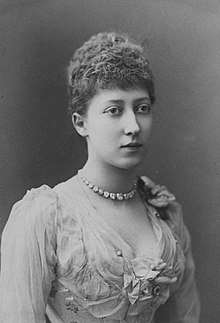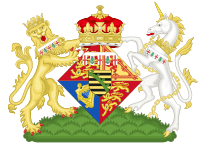Louise, Princess Royal
Louise, Princess Royal and Duchess of Fife VA, CI (Louise Victoria Alexandra Dagmar; 20 February 1867 – 4 January 1931) was the third child and the eldest daughter of the British king Edward VII and Alexandra of Denmark; she was a younger sister of George V. She was the eldest granddaughter of Christian IX of Denmark. In 1905, her father gave her the title of Princess Royal, which is usually bestowed on the eldest daughter of the British monarch if there is no living holder (e.g., the monarch's sister, designated in the previous reign).[1]
| Princess Louise | |||||
|---|---|---|---|---|---|
| Princess Royal, Duchess of Fife | |||||
 Louise in 1901 | |||||
| Born | 20 February 1867 Marlborough House, London | ||||
| Died | 4 January 1931 (aged 63) Portman Square, London | ||||
| Burial | 10 January 1931 | ||||
| Spouse | |||||
| Issue |
| ||||
| |||||
| House | Saxe-Coburg and Gotha (until 1917) Windsor (from 1917) | ||||
| Father | Edward VII | ||||
| Mother | Alexandra of Denmark | ||||
Early life
Princess Louise was born at Marlborough House, the London residence of her parents, then the Prince and Princess of Wales (later King Edward VII and Queen Alexandra). She spent much of her childhood at Sandringham House, her parents' country estate in Norfolk. Like her sisters, Princesses Victoria and Maud, she received limited formal education.
She was baptised at Marlborough House on 10 May 1867 by Charles Longley, Archbishop of Canterbury.[2]
She and her sisters, Maud and Victoria, were bridesmaids at the wedding of their paternal aunt Princess Beatrice to Prince Henry of Battenberg in 1885.[3]
Marriage and children

On Saturday 27 July 1889, Princess Louise married Alexander Duff, 6th Earl Fife, at the Private Chapel in Buckingham Palace.[4] Two days after the wedding, Queen Victoria created him Duke of Fife and Marquess of Macduff in the Peerage of the United Kingdom. The letters patent creating this dukedom contained the standard remainder to heirs male of the body lawfully begotten. However, it became apparent that the Duke and Duchess would not have a son. Therefore, on 24 April 1900, Queen Victoria signed letters patent creating a second Dukedom of Fife, along with the Earldom of Macduff in the Peerage of the United Kingdom with a special remainder: in default of a male heir, these peerages would pass to the daughters of the 1st Duke and then to their male descendants.
The Duke and Duchess of Fife had three children:
- Alastair Duff, Marquess of Macduff (stillborn 16 June 1890)
- Princess Alexandra, 2nd Duchess of Fife (17 May 1891 – 26 February 1959); married her first cousin once removed Prince Arthur of Connaught (13 January 1883 – 12 September 1938), and had issue.
- Princess Maud of Fife (3 April 1893 – 14 December 1945); married Charles Carnegie, 11th Earl of Southesk, and had issue.
Princess Royal
On 9 November 1905, King Edward VII created Princess Louise the Princess Royal, the highest honour bestowed on a female member of the royal family. At the same time, the King declared that the two daughters of the Princess Royal would be styled as princesses, with precedence immediately after all members of the royal family bearing the style of "Royal Highness".
In December 1911, while sailing to Egypt, the Princess Royal and her family were shipwrecked off the coast of Morocco. Although they escaped unharmed, the Duke of Fife fell ill with pleurisy, probably contracted as a result of the shipwreck. He died at Assuan, Egypt, in January 1912, and Princess Alexandra succeeded to his dukedom, becoming Duchess of Fife in her own right. Princess Alexandra later married Prince Arthur of Connaught, a first cousin of Princess Louise.
Later life and death
Princess Louise of Wales received the Royal Order of Victoria and Albert in 1885 and the Imperial Order of the Crown of India in 1887. She became a Lady of the Venerable Order of St John of Jerusalem (LJStJ) in 1888 and a Dame Grand Cross (GCStJ) of that order in 1929. She became colonel-in-chief of the 7th Dragoon Guards (the Princess Royal's Own) in 1914. She later served as colonel-in-chief of the 4th and 7th Dragoon Guards when it was formed in 1921.
In the autumn of 1929 at Mar Lodge she was taken ill with gastric hemorrhage and was brought back to London. The Princess Royal died fifteen months later in January 1931, at her home in Portman Square, London, at the age of 63 and was buried in St. George's Chapel, Windsor Castle. Her remains were later removed to the Private Chapel, Mar Lodge, Braemar, Aberdeenshire.
Titles, styles, honours and arms
Titles and styles
- 20 February 1867 – 27 July 1889: Her Royal Highness Princess Louise of Wales
- 27 July 1889 – 22 January 1901: Her Royal Highness Princess Louise, Duchess of Fife
- 22 January 1901 – 9 November 1905: Her Royal Highness The Princess Louise, Duchess of Fife
- 9 November 1905 – 4 January 1931: Her Royal Highness The Princess Royal
Honours
- 1914: Colonel-in-chief of the 7th Dragoon Guards[5]
- 1922: Colonel-in-chief of the 4th/7th Royal Dragoon Guards[5]
Arms
Upon her marriage, Princess Louise was granted a coat of arms, being those of the Royal Arms of the United Kingdom with an inescutcheon for Saxony, all differenced with a label argent of five points, the outer pair and centre bearing crosses gules, and the inner pair bearing thistles proper.[6] The inescutcheon was dropped by royal warrant in 1917.
 |
|
|---|---|
Ancestors
Notes
| Wikimedia Commons has media related to Louise, Princess Royal and Duchess of Fife. |
- "Royal Titles: Style and Title of the Princess Royal". The British Monarchy. n.d. Archived from the original on 27 July 2008. Retrieved 23 January 2018.CS1 maint: unfit url (link)
- Her godparents were her paternal aunts – Alice, Princess Louis of Hesse, Helena, Princess Christian of Schleswig-Holstein and Princess Louise, Duchess of Argyll; her paternal uncle (by marriage), Crown Prince Frederick of Prussia; her first cousin once-removed – Grand Duchess Augusta of Mecklenburg-Strelitz; her maternal great-uncle – Elector Frederick William of Hesse-Kassel (or Hesse-Cassel); her maternal grandmother: Queen Louise of Denmark – for whom she was named; her children, Louise's uncle, George I of Greece; and aunt, The Tsarevna of Russia; Duke Charles of Schleswig-Holstein-Sonderburg-Glücksburg; and Prince Edward of Saxe-Weimar-Eisenach.
- "Prince and Princess Henry of Battenberg with their bridesmaids and others on their wedding day". National Portrait Gallery. Retrieved 30 May 2018.
- Her bridesmaids were The Princesses Maud and Victoria of Wales, Victoria Mary of Teck, Marie Louise and Helena Victoria of Schleswig-Holstein and The Countesses Feodora, Helena and Victoria Gleichen
- Michaels, Beth (15 August 2014). "The 10 Princesses Royal". History and Headlines. Retrieved 30 May 2018.
- Heraldica – British Royal Cadency
Louise, Princess Royal Cadet branch of the House of Wettin Born: 20 February 1867 Died: 4 January 1931 | ||
| British royalty | ||
|---|---|---|
| Preceded by Victoria, German Empress |
Princess Royal 1905–1931 |
Succeeded by Princess Mary, Countess of Harewood |